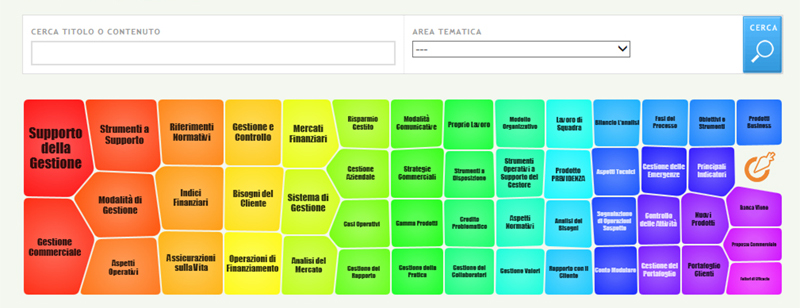“Capusability” is an ambitious project, launched in 2013 by the Centro di Formazione di Intesa Sanpaolo in collaboration with Intesa Formazione Scpa. Its objective is to activate, in their employees, courses of spontaneous self-learning with a view to lifelong learning, by using the training resources already existing within the company. Indeed, companies often invest in training, producing documents, e-learning objects, videos and presentations whose life-cycle quickly ends because, once the launching period of an initiative is over, people tend to stop accessing its content even though it remains present in the company repository. And even if employees should want to access the training content, it is often hard to find or access. This situation makes the return on investment for the design and development of content less efficient. The project encourages different practices and for this reason there was an initial phase of census and cataloguing of the existing multimedia materials, done in collaboration with Amicucci Formazione, followed by an analysis of the professional profiles for whom focused learning courses were proposed. In order to catalogue the various didactic materials, a tool for Automatic Tagging and Clustering of content was used, developed by Infofactory, which analysed the documentation of every course and all the comments associated with it and classified it through tags that were generated automatically. At the same time, various employee profiles were mapped, considering their roles and the relevant skills needed to bridge the training gaps. Moreover, various employees’ learning profiles were identified in order to offer them content that was the most appropriate for their personal characteristics. To identify everyone’s learning style, those involved in the pilot scheme were given an ad hoc questionnaire (according to the logic of aptitude tests) which led to the definition and mapping of 4 different learning styles. As well as the training requirements necessary for the different positions within the company, during the course of the project possible “connections” were identified between training items and “skills and personal interests” that could be useful at work. This was done by analysing people’s interactions within the training platform, the comments and evaluations on the training courses they did and the skill tags colleagues assigned each other by using features already present in the company’s social network. By combining the data obtained from the classification of the training items with a person’s profile, an engine of adaptive and personalised recommendations (which uses an algorithm based on the if-then rule and a semantic analysis logic of clusters using a matching algorithm) proposes to users training content that would be useful to them based on the position they hold, as well as suggesting didactic material which could be of interest to the person based on their personal characteristics. The approach used is similar to the individual coaching that is usually used for senior employees, but the automatic method of defining an individual training course lowers costs, making it possible to use it for all the company’s employees.  The project is currently in the pilot phase: about 1,200 training items have been analysed, and a sample of about 100 users has been selected, which represents the workforce, as well as a control group. Evaluation of the project will be carried out through interviews with those who have used the new tool, thus assessing if having access to different courses is more effective than with the control group. The expected benefits include a greater reuse of training content, an increase in people’s skills through this new system of “automatic coaching”, less time dedicated to training due to a more efficient research of content and an increase in employees’ satisfaction. Link to the article – Il Sole 24 Ore Riccardo Bubbio Head of Development & Project IntesaSanpaolo Formazione
The project is currently in the pilot phase: about 1,200 training items have been analysed, and a sample of about 100 users has been selected, which represents the workforce, as well as a control group. Evaluation of the project will be carried out through interviews with those who have used the new tool, thus assessing if having access to different courses is more effective than with the control group. The expected benefits include a greater reuse of training content, an increase in people’s skills through this new system of “automatic coaching”, less time dedicated to training due to a more efficient research of content and an increase in employees’ satisfaction. Link to the article – Il Sole 24 Ore Riccardo Bubbio Head of Development & Project IntesaSanpaolo Formazione
insights